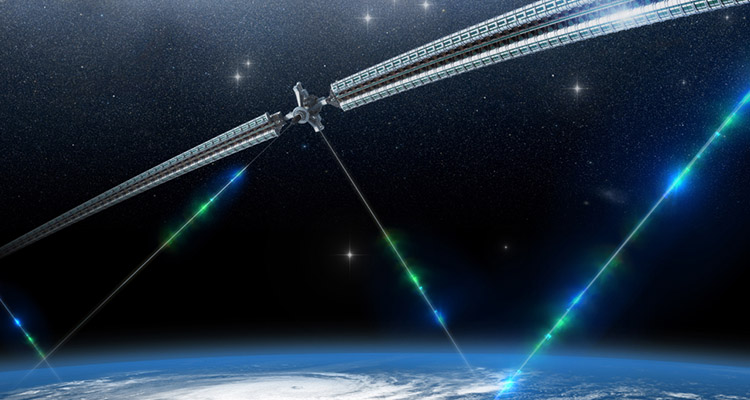Space Elevator, Dream or Reality?

Although the idea of stretching a cable between earth’s surface and a point some 36 000 kms above the horizon (geo-synchronous orbit) to form a space elevator presents some formidable engineering challenges, the idea is far more feasible than say, establishing a colony of humans on Mars, simply because the issues revolve mainly around the strength of the cable, and how to attach it to earth’s surface to withstand the enormous resulting centrifugal forces. Most of the work involved in propelling a payload along the cable can be done by the earth’s rotation, so all that remains is making a cable that is strong enough, but is this possible, and what is a space elevator exactly, and how will it work?
Space elevators explained.
As the name suggests, a space elevator is a mechanism through which loads can be lifted into space without burning enormous amounts of fuel. The basic idea was first proposed by Konstantin Tsiolkovsky, a Russian rocket scientist, as long ago as 1895, when he was inspired by the Eifel Tower in Paris, France.

The idea entails nothing more than a cable that is tethered to earth, with the other end anchored in space by a weight to hold the cable taut by means of the centrifugal force imparted by the earth’s rotation. It is however important to note that the cable has to be exactly 35,786 kms long to enable the counterweight to maintain its position exactly “above” the attachment point on earth.
If the cable is too short, the attachment point will overtake the free end, causing the cable to lag behind, and if the cable it too long, the free end will overtake the attachment point, with either a resulting loss of tension, or an increase in tension that could conceivably sever the cable. However, there is more to it, which brings us to-
How will it work?
The mass of the counterweight is key to success of a space elevator, because the heavier the cable is, the less weight is required at the free end, since a high percentage of the centrifugal force will be carried by the cable itself, because it has a large mass. The converse is also true, which raises the question of how much the mass of a payload will deflect the cable during its rise toward the counterweight.
It is imperative that the cable be kept taut at all times, but it is inevitable that some deflection of the cable will take place before the payload reaches a point along the cable where its velocity matches the centrifugal force exerted on the counterweight. Before this point, the payload’s inertia will deflect the cable, thus pulling the counterweight towards earth, which could have the effect of causing the attachment point to overtake the counterweight, causing the entire system to lag behind. The obvious answer is of course not to lift heavy payloads, so as not to cause deflection of the cable, which raises the question of what the practical applications of a space elevator could be.
With a sufficiently strong cable, and a counterweight it match, it would in theory be possible to launch heavy satellites, but the problem of how to detach it from the cable before it smashes into the counterweight would need some careful thinking about, although this seems like a minor technical detail now, but only because nobody is working on solving it.
Nonetheless, the problem of propelling heavy payloads along the cable remains, especially at low elevations. The object would be to propel payloads at the same rate at which the attachment point orbits the earth’s centre, so as not to deflect the cable, but how to accomplish this is not yet clear.
Objects at the equator move at a velocity of 1,040 mph (1673.7 km/h), which means that to match the velocity of the cable, the payload would have to be lifted off the earth’s surface at the same rate of speed, so as not to interfere with the tension of the cable. How this will be done remains an open question.
One way ticket?
There is another problem however. It would seem that objects travelling along the space elevator might not be able to return to the surface. Objects on the downward journey have to re-enter the atmosphere, and have to be slowed sufficiently to prevent them from burning up in the upper atmosphere.
Mechanisms to control descent speeds will have to be developed, since gravity will be the driving force behind the descent. One possible solution might involve parachutes, but how to do this without the cable interfering with the deployment of drag ‘chutes remains a problem. Mechanical braking systems are out of the question, which leaves retro-firing rockets as a possibility, but the fuel required will have a huge negative impact on useful payload weights, which in turn, might conceivably make a space elevator a non-viable proposition- unless of course, no loads are ever brought down the elevator.
What to use as a cable?
Current technology is incapable of creating a cable of sufficient strength, and it is pointless listing the tensile strengths of available materials here. What is required is something new, but as it happens, there is a possible candidate material available. However, the problem is making in sufficiently long lengths to be of practical use.
The material under investigation for use in a space elevator is carbon, but with a molecular arrangement similar to diamonds. Referred to as “carbon nanotubes”, this material can be described as a seamless cylinder consisting of hexagonally arranged carbon atoms, with the atoms arranged in sheets no more than one atom thick. With a diameter of 1 nanometre (1 billionth of a metre), carbon nanotubes have a theoretical tensile strength of 130 Gpa, which is 200 times that of the best stainless steel.
If woven together, this material will provide ample strength for any space elevator; however, the problem is that it cannot as yet be made in lengths above a few inches long. The longest carbon nanotube in existence is only 20 cm long, and although this material can be produced for substantially less than $100 per gram, the main issue revolves around the difficulty in eliminating manufacturing flaws in long lengths.
Although hundreds of millions of dollars are being spent on researching new manufacturing methods, the fact is that currently, there are no known ways to produce long lengths of carbon nanotubes of uniform strength. One of the main problems is the propensity of carbon atoms to bond with the catalysts used to produce nanotubes, thus causing “weak spots” in the structure because the carbon atoms deactivate the catalysts.
Even the most advanced methods of manufacture can only produce nanotubes of a few centimetres long, and problems such as “thermodynamically unavoidable atomistic defects”, “elastic plasticity”, “non-asymptotic regimes”, “finite domains”, and others remain to be resolved, which in practice, has proven to be impossible with the current state of manufacturing methods.
It also means that at the moment, there is no suitable material with which to make space elevators, and the dream of space elevators will remain just that, a dream, at least for the foreseeable future.

A dream in the making?
Current experiments with space elevators show that we are still in its early stages and although the use of solar power and lasers as viable means of propulsion along the cable has been shown to be effective at small scales (and even smaller payload masses), we are still a while from constructing a large scale working model.
But then again, less than a hundred years ago the idea of walking on the moon was a joke even among serious scientists, so who can tell what the next few decades hold in store? More information on space elevators is available here.


